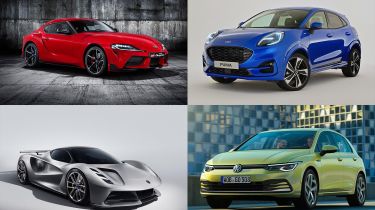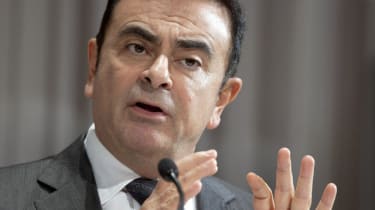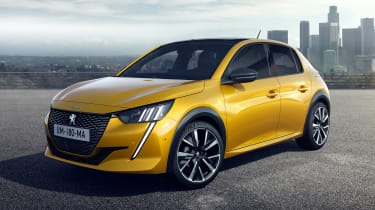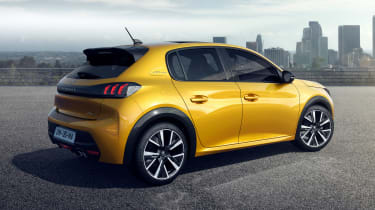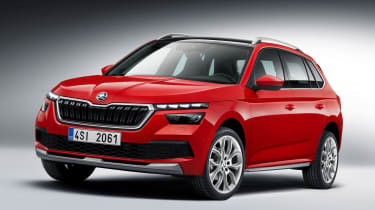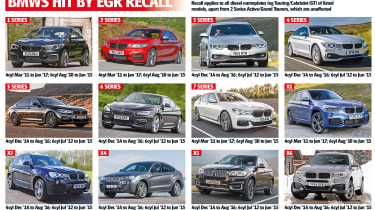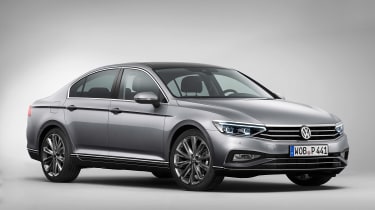Headline grabbers: best car news stories of 2019
From hatchbacks to hypercars, all manner of cars grabbed headlines in 2019, but these were some of the biggest and best news stories
Another year has come to a close. 2019 was packed to the rafters with news, with a host of new cars emerging, as well as scandals, deaths and recalls also hitting the headlines in the course of the past 12 months.
Once again SUVs proved their popularity with even more manufacturers jumping on the bandwagon. Marques such as Aston Martin entered the ever-growing sector with the DBX, while Volkswagen and Ford filled niches with their respective T-Cross and Puma crossovers.
Electric cars hit the headlines again in 2019 with more emphasis on cheaper prices, bigger batteries and increased range. Volkswagen revealed the production-ready ID.3, targeting everyday households, while at the other end of the market, the Taycan made its first appearance as Porsche’s flagship model with a price tag starting north of £100,000.
Despite electrification being seen as the future of motoring, that didn’t stop a few brands from flying the flag for fire breathing petrol engines. Toyota finally gave us the Supra back in January after what seemed like a lifetime of teasing while Mercedes went mad and jammed a 415bhp turbocharged four-cylinder engine into its A-Class - creating the most powerful hot hatch ever in the process.
It wasn’t all big reveals though, as plenty of important consumer stories also made big impacts on the industry and motorists. Parking fines, car theft and number plate cloning all rose dramatically while concerns over the safety of smart motorways grew. Plus, a controversial ruling back in March saw the start of mandatory speed limiters being introduced in all European cars.
Scroll down or click on the anchor links below to read our round-up of the biggest news stories of 2019...
Jan-Feb • Mar-Apr • May-Jun • Jul-Aug • Sep-Oct-Nov
January
Toyota builds on its sports car heritage with brand-new Supra
Toyota kicked off 2019 with the car that had been four long years in the making – the all-new Supra. The much-anticipated successor to the last Supra that arrived in 1993 had been the subject of years of rumours, teasers and online speculation, but we got our first look at the new model at January’s Detroit Motor Show.
Despite Toyota being one of the world’s biggest automotive manufacturers, the car was developed in conjunction with BMW and the new Z4. Both models share the same chassis, engine and hardware in order to keep costs down – sales of two-door sports cars are relatively small, so both companies had to find a suitable partner in order to make their respective projects viable.
The new Supra measures in at 4,379mm in length, 1,292mm in height and 1,854mm in width, making it longer, lower and wider than a Toyota GT86. The wheelbase is shorter, however, and the tyres are wider, which Toyota said was designed to give a sharper and more engaging driving experience. Toyota’s Gazoo Racing team also helped develop the Supra to ensure the model could deliver the best-possible performance on road and on track.
The shape and overall look of the new Supra are reminiscent of those of the 1993 car, but they’ve been modernised with slender LED headlamps and sharper, more aggressive bodywork. However, there are also some additional retro touches in the mix, such as the ‘double-bubble’ roof – a nod to the Toyota 2000GT from the sixties. Inside, though, it’s a different story; the cabin design and overall architecture are virtually identical to those found in the BMW Z4. The same steering wheel, infotainment system and dashboard can also be seen in the Z4 roadster.
All Supras sold in Europe are powered by – you guessed it – a BMW-sourced turbocharged 3.0-litre six-cylinder, which puts out 335bhp and 500Nm of torque. As standard it’s paired with an eight-speed ZF auto box that sends power to the rear wheels. Toyota says that makes it good for a 0-62mph time of 4.3 seconds and a 155mph top speed. Under the skin, the Supra also features an active differential, which is operated by a dedicated control unit. This is able to monitor a variety of vehicle parameters from throttle input to chassis yaw rate, and then adjust the amount of torque between the rear wheels in order to maximise both traction and performance.
Latest Renault Clio first to have hybrid drive
Renault pulled the wraps off the fifth-generation Clio at the beginning of the year, promising extra tech and space plus a range of more efficient engines. Based on a fresh platform, called CMF-B, the model also has all-new panels – despite the car looking rather like its predecessor. It’s also the first Clio to be offered with a hybrid powertrain; a 1.6-litre petrol engine is mated to a pair of electric motors and a 1.2kWh lithium-ion battery, which Renault says should allow low-speed driving in fully electric mode. The big changes come inside, however, with a new portrait infotainment system and plusher materials.
Car thefts increase by 50 per cent
The number of cars stolen in the UK increased by nearly 50 per cent over a five-year period, Home Office figures published in January revealed. Police forces across the country received reports of 111,999 stolen vehicles in 2017/18 – a 48.7 per cent increase on 2013/14’s figure of 75,308. The data also showed an 8.4 per cent year-on-year rise in incidents of items being stolen from vehicles, up from 258,346 in 2016/17 to 280,032 in 2017/18. The theft increases came at the same time as the advent in keyless technology and a fall in numbers of road-traffic officers.
Troubled Renault boss Ghosn steps down
It was a bad start to the year for Carlos Ghosn, who eventually – but voluntarily – decided to step down from his position as the boss of Renault. This saga rolled on from the end of 2018, when he was arrested in Japan on charges of misconduct and understating his pay. Ghosn made the decision to step aside while still in jail in Japan, because he was denied bail.
Roads spending down; parking fines up
Local councils slashed their road spending by £400million over four years, despite having seen a £165m rise in revenue from their parking operations. Confused.com analysis revealed councils in England, Wales and Scotland made £847m net revenue from all parking charges and fines in 2017/18, compared with £682m in 2013/14, but cut road spending from £2.8 billion to £2.4bn.
February
Peugeot 208 is first ’mini to offer petrol, diesel and electric power
Peugeot was first out of the blocks with its all-new 208 supermini in the run-up to the Geneva Motor Show. The Ford Fiesta rival has lagged behind its rivals in virtually every aspect, so the French brand took a rather radical approach with the latest model. Based on a new platform, called CMP, the 208 is the first Peugeot to be offered as petrol, diesel and fully electric model. This is a real USP for the supermini, because it’s also the first car in its class to be offered with a trio of different powertrains.
The entry-level PureTech 75 has a 74bhp 1.2-litre petrol three-cylinder that propels the front wheels via a five-speed manual box. A more muscular PureTech 100 turbo takes power up to 99bhp and gets a six-speed manual. Peugeot’s EAT eight-speed automatic is optional with this edition, while the top-spec 128bhp PureTech 130 features the auto as standard.
As diesel sales continue to dwindle, especially in smaller cars such as the 208, the only option here is a 99bhp 1.5-litre four-cylinder paired with a six-speed manual. It’s expected to make up only a fraction of all 208 sales. The most interesting of the trio is the electric e-208. It’s powered by a 50kWh battery that drives a 134bhp electric motor on the front axle. Peugeot says it’s good for up to 211 miles on a single charge.
Whichever edition you go for, one thing will remain consistent: the design. Peugeot has intentionally made the electric version identical to the conventional petrol and diesel models, so as not to deter buyers with an alienating EV design. Elements of the latest 208’s styling nod to the French firm’s past. The curved C-pillar and thick black arch extensions are an homage to the legendary 205 GTi, but Peugeot’s modern-day design cues are still present in the fang-shaped LED daytime running lights and claw-like headlamps.
The cabin is a big step on from any other supermini, too. A new 3D version of Peugeot’s trademark i-Cockpit makes its debut, and ‘piano key’ switchgear replaces a lot of conventional switches to give a more upmarket look. All models also feature touchscreen infotainment; on lower-spec variants it is a seven-inch display, while top-spec editions get a larger 10-inch unit.
Kamiq is Skoda’s entry-level SUV
Skoda completed its SUV line-up in February with the launch of the Kamiq crossover. The new model is designed as the entry-point for Skoda’s SUV range, and sits beneath the Karoq and Kodiaq models as a rival for the popular Nissan Juke.
The Kamiq is the largest car in its class, at 4.24m long, which should come as little surprise for a car from a manufacturer that puts practicality ahead of everything else. As a result the Kamiq has as much rear passenger space as the larger Octavia hatchback, while the 400-litre boot puts it ahead of many of its rivals. There are plenty of Skoda’s ‘simply clever’ features, too, including an LED torch in the boot and an ice scraper behind the fuel filler cap.
The car has plenty of tech inside as well, with a 10.25-inch digital instrument cluster sitting alongside a 9.2-inch central display on the dash. The crossover shares a platform with the Scala hatchback, so the familiar engine and gearbox options include 1.0 and 1.5-litre petrols, and a 1.6-litre diesel.
Recall leaves BMW owners car-less
A BMW recall left some owners having to go for up to two months without their cars after the maker admitted there were issues with part supplies and workshop availability. The recall campaign was launched in October 2018, and identified 268,000 diesel BMWs in the UK – out of 1.6 million worldwide – that had the potential to suffer a glycol leak in the exhaust gas recirculation valve coolers, leading to fire “in extreme cases”. The huge parts demand placed unprecedented strain on BMW’s suppliers, with many customers left stuck with courtesy cars.
Ford reveals most powerful Focus ST
Ford revealed the latest version of its Mk4 Focus ST at the beginning of the year, and it remained the only car maker to offer its hot hatch with the choice of either petrol or diesel power. This Focus ST is the most powerful the firm has ever produced; the 2.3-litre turbo, derived from the old Focus RS’s, develops 276bhp and 420Nm of torque. And while the diesel can’t quite match those figures, the 2.0-litre EcoBlue diesel still puts out 187bhp and 400Nm, allowing a 0-62mph of 7.6 seconds. Better still, you can even have the Focus ST as an estate if you need practicality.
Style and PHEV tweaks for Volkswagen Passat
The Passat was given a fresh lease of life in February, with a range of tweaks and the arrival of a more efficient version of the plug-in hybrid GTE. Both the saloon and estate received reshaped bumpers and new headlamps. Company car drivers were the most pleased, because the fuel-sipping GTE was updated with a larger battery, allowing 35 miles of pure-electric driving.
Jan-Feb • Mar-Apr • May-Jun • Jul-Aug • Sep-Oct-Nov
Review of the Year 2019

• Best car news stories of 2019• Best car reviews of 2019• Best car group tests of 2019• Best long-term tests of 2019• Best motoring features of 2019• Best car videos of 2019• Best motorsport stories of 2019• Our highlights of 2019
Click onto page 2 to continue reading the big news stories of 2019...
Find a car with the experts
